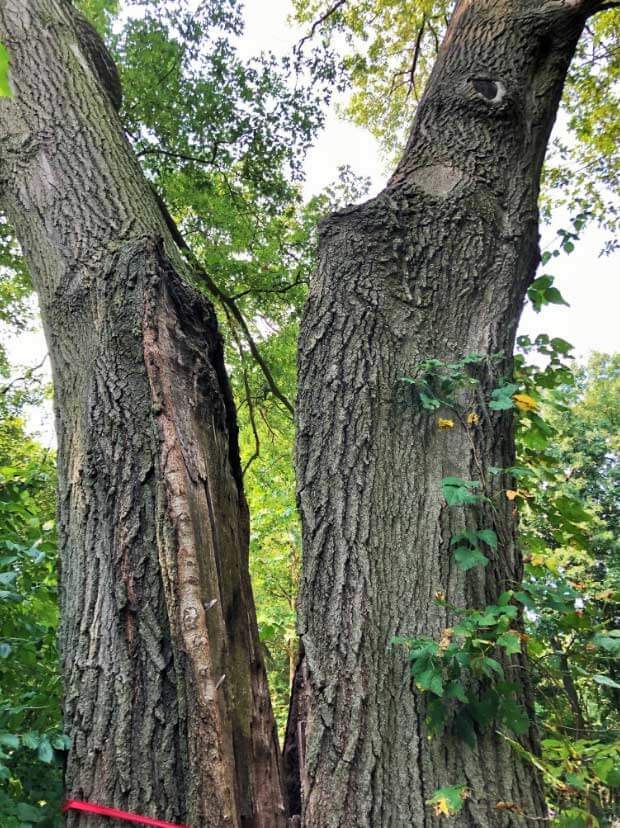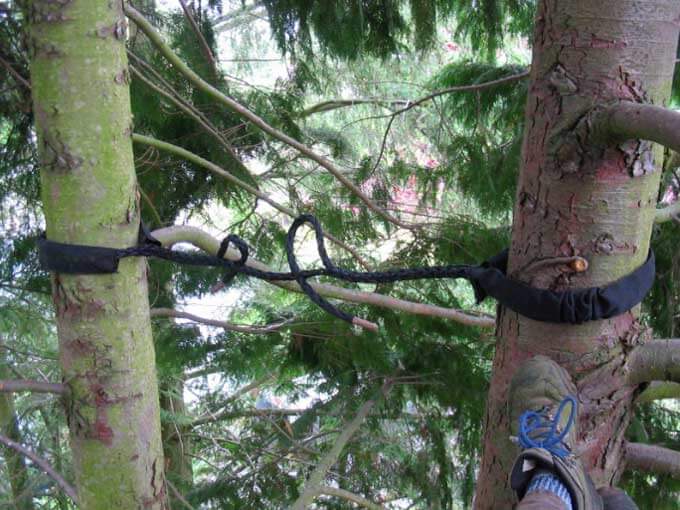Trees or branches featuring bark inclusion typically need immediate attention. It’s critical to consult with a tree specialist to examine them before they break apart or perish. Discover essential information about bark inclusion and ways to tackle it to preserve your tree.
Included bark or “ingrown bark”, is a condition that mostly affects multi-stemmed trees or those with co-dominant leader branches or limbs.
The bark at the dividing point usually grows inwards forming a soft mass. Included bark can cause competing stems, branches, or limbs to split or die. Cabling, bracing, pruning, and tree removal are the recommended solutions for trees with bark inclusion.
What we cover
ToggleHow to Identify Included Bark
A tree with included bark is easy to spot especially if the problem occurs at the junction of co-dominant stems1 or leader branches. The affected area may appear wrinkled, ridged, turned in, or have a different color in some trees. Sometimes the affected bark tissue appears rotten or soft to the touch.

Physical signs that a tree has a bark inclusion include the following:
- Soft intersecting bark on multi-stemmed trees
- The stem junction or branch attachment may appear wrinkled or ridged
- A V-shaped crotch or gap at the junction of stems or limbs is usually a big sign of an included bark on some species, even in young tree seedlings. U-shaped junctions are less likely to have included bark.
- Different colored bark at the junction point- usually darker than the rest of the limb or stem.
- The bark at the junction of the stems may be soft to the touch or appear rotten.
Some species may develop barely visible but dangerous bark inclusions. Such trees usually fall or split apart without warning. Invisible bark inclusions2 occur when no wood is holding a branch or stem together on the inside.
What Causes Included Bark?
There are many reasons why a tree could have included bark. Some trees naturally develop inclusions at a young age and need constant care through trimming and pruning. At the same time, naturally, growing multi-stemmed trees can develop included bark as a result of their shape or structure.
In most cases, included bark occurs when two stems or branches grow too close to each other. This causes the bark at the junction to fold in, rot, or crack. Trees that were not properly spaced out or growing next to a solid wall may develop including bark.
Preventing and Managing Included Bark
There are a few ways you or a professional tree surgeon can manage or prevent bark. Most of these can be done at different stages of a tree although some may not be suitable for fully mature trees or those with severe bark inclusion.
Crown Reduction
Reducing the crown of a tree while it is relatively young and healthy is one of the ways you can prevent bark inclusion. By reducing the number of limbs or branches competing for space on the crown, you will be creating more room for the limbs to spread out and develop strong U-shaped junctions with real wood.
Crown reduction can also be used in trees that already have included bark. Trim or cut off branches that have very weak and visible bark inclusion to provide room for others and as a safety measure. Weak branches or limbs with included bark can prevent other branches from spreading out.
Cabling and Bracing
Cabling or bracing are two radical but effective ways to save trees with included bark. Both methods can prevent the tree from splitting apart or losing important limbs as it grows. It is recommended to hire a trained tree surgeon or arborist to brace or cable mature trees.
Cabling involves using wires to tie a tree stem or branches in a certain way to manage how they grow. This method can be used to reinforce weak branches or limbs with included bark at a young age. However, it may not be effective for mature or old trees.
Bracing involves adding steel rods onto a multi-stem tree or limb where there is included bark and securing the rods with caps on either side. The rods will prevent the tree from splitting apart. Bracing is usually more effective for younger trees with signs of bark inclusion.

Removal of The Tree
If a tree has a severe bark inclusion problem affecting the stem or major branches, then it can be removed entirely for safety purposes. Removal may be the only available option for some trees, especially those growing next to buildings, roads, and electrical installations. Have an arborist check if the tree can be saved before you remove it.
What Impact Can Included Bark Have on The Tree?
Included bark usually causes a tree to develop weak junctions on stems (for multi-stemmed trees) and branches. The affected stem branches are usually weak and can easily split apart or break off after some time or if subjected to twisting or lateral forces in rough weather. Included bark may also cause a tree to rot and lean or die in severe cases.
The Right Time to Take Care of Included Bark
The best time to manage included bark is when a tree is young or when you are planting it as a seedling. Always have your trees checked for signs of bark inclusion at a young age and pruned cabled or braced. This will ensure the tree can adopt a strong structure as it grows. Bracing or cabling mature trees is usually more complicated and less effective.
Is Treating “Included Bark” A DIY Project?
Only treat included bark through cabling, bracing, or pruning if you are experienced or trained to do it safely without killing the tree or causing irreversible damage. For most people, having a trained tree surgeon or arborist take a look at the tree and treat it is the best solution.
Tip: Finding a qualified tree surgeon in your location can be a daunting task for most people. To make it easier for you, we have a free tree service location tool embedded on this web page. To use it, just scroll to the top and enter your zip code to find top-rated professionals in your location.
FAQ's
It is normal for some trees to develop co-dominant stems or have a double-stem structure. Such trees are vulnerable to bark inclusion which may cause them to split at some point due to weak junctions. Keep an eye out for included bark and have your trees checked.
A bark ridge is the raised section on the junction of a branch or tree limb to the stem. The branch bark ridge creates a strong bond between the branch and the stem and should never be cut when pruning or trimming.
- Shigo, A. (2019) Co-dominant Stems. <http://www.treedictionary.com/DICT2003/tree_pruning/codom_leaders/index.html> Accessed: 22-02-2024
- Gilman, E.F., (2019) Bark Inclusions. <https://hort.ifas.ufl.edu/woody/bark-inclusions.shtml> Accessed: 22-02-2024




